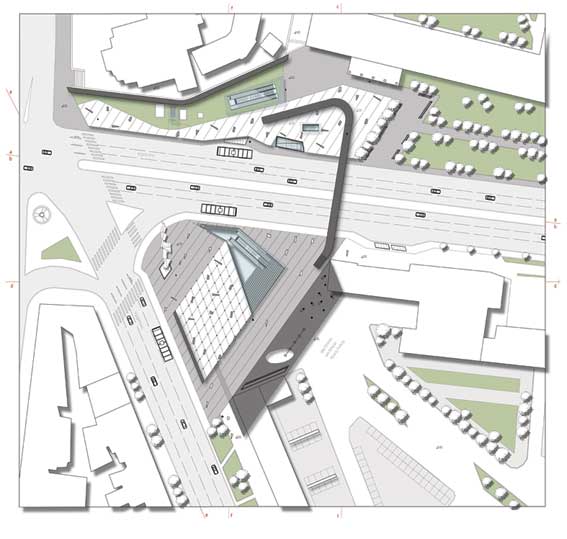

The works for the Metro of Thessaloniki have already started. The first and only line, for the time being, starts at the New Railway
Station and stops at the Park of Nea Elvetia, running underground Egnatia Street.
The composition of this diploma concerns the creation of the metro station on the crossroads of Aggelaki and Egnatia streets known as the Syntrivani area. This is the whereabouts of the Theological school of the Aristotle University, the International fair of Thessaloniki, the Children’s Asylum and the ABC hotel, making it a popular and much frequented metro station.
The designing of the station includes a square on the level of Egnatia street where the entrances of the station, the emergency exits and the ventilators are. Besides the tow entrances to the station the new Syntrivani Square includes an elevator for people with special needs, roofed ramp as well as a footbridge which links the tow sides of the square.
The impressive sculpture of G. Zoggolopoulos remains on site while the existing northwest entrance to the International Fair (EXPO) is demolished and replaced by a new gate which allows the eye to have an open view leading to the Telecom Tower.
This way, both the station and the International Fair co-exist in a unity creatingthenewSyntrivaniSquare.
Supervisor: Triantafillidis Giorgos
Reference Number: 201


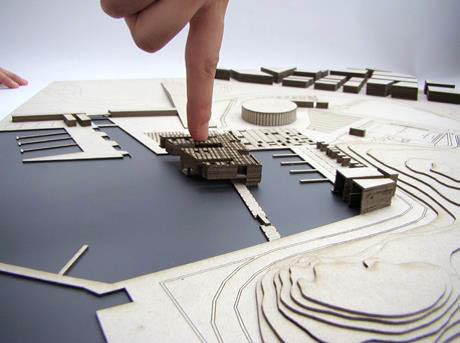

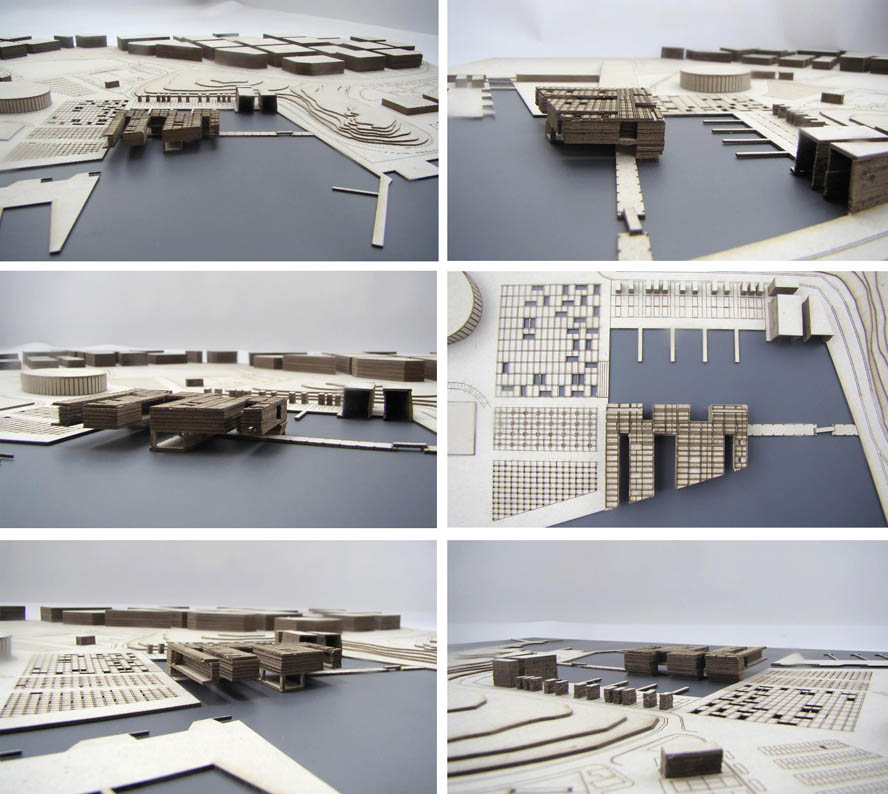



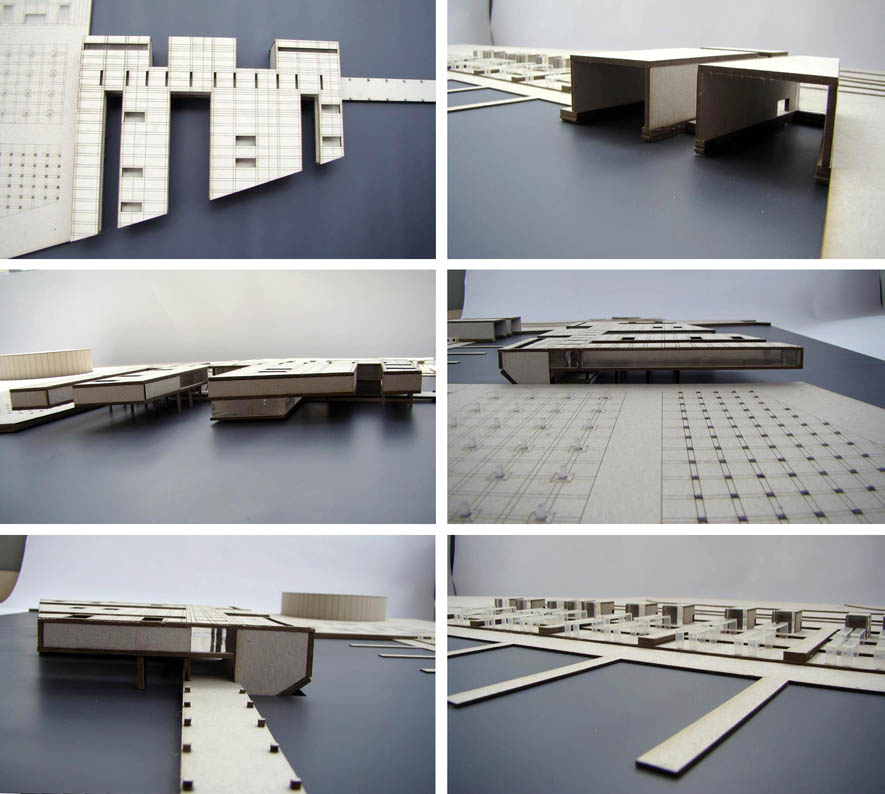



'Phaleron' means white, pure, transparent, foamy. The ancient Phaleron in Archaic and Classical times was the most important port of the time, until Themistocles and later Pericles formed the port of Piraeus and Phaleron became the second port of Athens.
Falirikos Bay is the natural outlet of the basin of Athens to the Saronic Gulf, where a resident of densely populated Athens has the opportunity of contact with water. In the early 1970s the bay was destroyed in the name of tourism development with extensive embankment, construction of the Flisvos marina and elevated Possidonos Ave. The organization of the Olympic Games in 2004 was associated with the construction of several new projects. After the Olympic Games the projects were abandoned and the areas that once bustled with life are now desolated and so the problems of urban space have exacerbated.
There was therefore a strong need to create an attraction pole, able to give life to this area and offer residents a place off and out of the urban web of the city. The first point was focused on the way the esplanade ends up in the water. We decided to keep the two hills intact since they formed a unique natural asset and were considered 'sacred' if we consider the existence of the ancient cemetery of Faliro.
The imaginary line created by the esplanade and the cement port boundary were the main routes of the creation of our intervention. The pattern that emerged referred to a 'funnel' which was prepared to attract and absorb any visitor who commenced his drive from the esplanade to Faliro Bay. The existence of an artificial cluster of trees to the finish of the esplanade was the initial stimulus- in combination with the masts of the sailing vessels- which prompted us to design a grid 10X10 piles in the water which then became the foundation of the “airborne”, maritime museum. Our intention to place vessels as exhibits in the building led to the creation of notches which host and exhibit ships in their natural element.
The museum functions as a limit as well as an extension of the esplanade. Now the extension of the esplanade has a dual character. It functions as an association of two opposite banks joining the area of intervention with the galley and the Battleship Averof . It also constitutes the open grounds of the museum, an area of the museum where the public has the opportunity to observe on their right and left tied vessels - exhibits. On the corridor there is the entrance to the naval museum. The visitor to the museum is first forced to 'sink' in the lobby and then emerge at the center of the museum. By the same token, the sinking and the emergence, function the library and auditorium, parts of which are immersed in water . The program includes sites of periodic exhibition, a permanent exhibition, the administration of the museum, an area with an educational aspect and models, bookstore, cafe-restaurant, an area of virtual navigation and a maintenance area. A large corridor runs along the building and the above mentioned areas are on its right and left. The total area of the building is 7400 sq.m.
Before entering the museum we felt that it was necessary to create a relaxation site. Thus we designed three squares. Starting from the side of the sea we come across the 'square glass', the' water square 'and the' Square of the exhibition.
Apart from the redefinition of the esplanade we develop a plan for the regeneration of the coastal front of Marina Faliro. The new port is composed of levels of 25 cm, which range from sea level to street level across the region. In the most shaped beach front over the marina activities we placed cafes and restaurants wishing to achieve a line of relaxation . On the harbor we come across two museum –type arsenals where vessels that are part of the exhibition enter and there is a representation of a rudimentary way of maintenance. At the end of this zone and behind the arsenal we mounted a two-storey building with offices of general areas of supervision and administration of the harbor and the wider region.
Supervisor: Papadopoulos Spiros
Reference Number: 214


At the beginning of Sophocles’s play “Oedipus at Colonus”, blind Oedipus, and his -daughter and sister- Antigone are at the hill of Ippios Colonus. Here, at the end of the play, Oedipus will die. Antigone, being also Oedipus eyes, gazes at the city walls in the foreground and when he asks she responds that the city is Athens.
In his article “Look Oedipus, this is Athens”, Zissis Kotionis reports that if Oedipus was standing at the hill of Colonus in our days, he would not be able to see the city walls or the Acropolis ahead, because the modern city’s mass prevents his sight. If we remove that mass, Oedipus will see the Akropolis.
My present project suggests that the theatrical scene at Colonus in witch Oedipus will stand, can be placed at a height where the sight of Oedipus could pass above the city mass.
It is a proposal for a cylindrical building, placed upon the hill, witch will be used as a theatre and a theatrical library also.
Supervisors: Kotionis Zissis, Manidaki Eva
Reference Number: 223






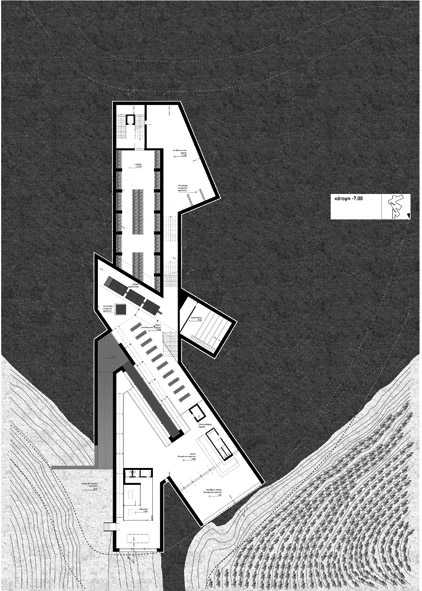





This degree thesis is about designing a winery on the island of Chios, and specifically in the northwestern part of it. A critical factor that led us to the selection of this project and subsequently this particular location was the glorious history of the island on the wine making and also historical and mythical references that can be found even in Homer’s works.
The site is located in the mountainous part of the island, in the municipality of Amani, near to the small village of Kourounia. The exact location of the winery is beyond the village, but in a spot from where it is visible. Round about there are vineyards, which are exploited by villagers for domestic purposes.
We aim to design a contemporary winery, which will give us high quality wine, appropriate for exportation. We intended that the winery would be unified with the landscape, and at the same time it would benefit from the advantages of the site, such as its orientation, the view, the inclination and the propitious climate of the area.
In conclusion, the interrelation of architecture and wine making, has no other purpose but to create the best conditions for the winemaking process, such as the functionality of materials and space, thermal conditions and the incorporation to the landscape.
Supervisor: Papadopoulos Spiros
Reference Number: 213
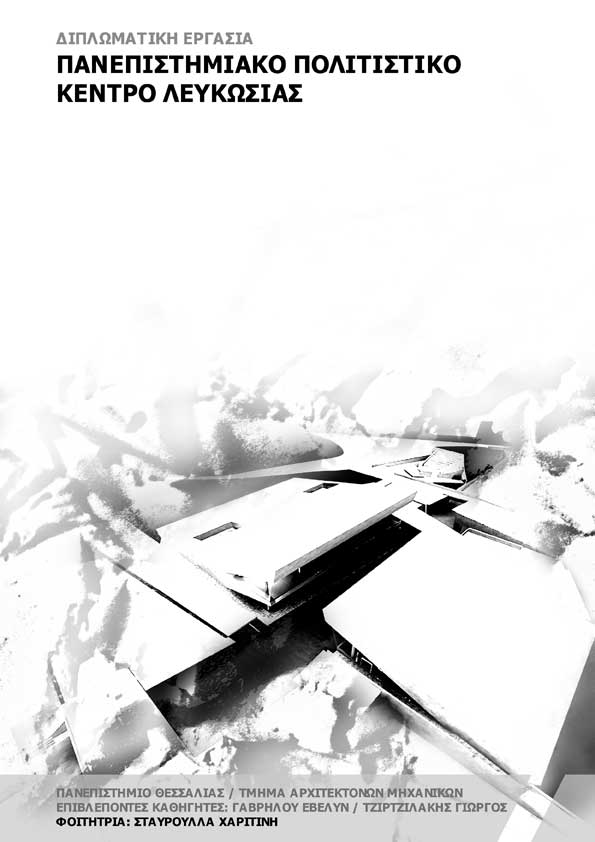

The subject of the diploma work concerns the study and planning of the Nicosia’s academic cultural centre. The subject is result of the need for the creation of a cultural centre in the university campus, which will serve the intensification of culture, for the students and residents of the city.
The building brief of the cultural centre includes amongst other facilities, an indoor amphitheatre with maximum capacity of 1000 individuals. Official ceremonies, graduations, congresses, theatrical plays, operas, concerts and movies could be hosted. It will also host, permanent and periodical art exhibitions.
The objective of this study, is to create of a cultural centre which converses with existing and the under study buildings of the campus in a harmonic manner within the general master plan. Also the flexibility of the building brief will encourage and strengthen the creativity of students.
The building brief aimed to serve the needs both, the university and the city too. Properly equipped areas will be used by the citizens for learning and teaching of various Cypriot traditional arts. The operations that coexist in the building can also be used autonomously. In this way various activities can take place in the building at the same time. The surrounding area of the building has been designed as a cultural square which visitors will find it interesting to cross.
The academic cultural centre is the only building of the campus that is directly associated with the city of Nicosia. City and university are responsible for any activities that unfold in the academic cultural centre. Students and citizens (main characters of these activities) function as energy carriers that channel their energy in the cultural centre which assembles, transforms, evolves and then defuses this energy.
This process was identified and managed as a natural explosion. The plot topography is the continuation of the natural landscape (hill and valley) that exists on its eastern limits. Taking tectonics as a base, treated the plot as a lot of layers in which a vertical force is applied, from below to above, and this caused sudden rupture and lift of the tectonic plates. The height of the lift, is relative to their distance from the centre of explosion. The explosion created a crack that crosses and separates the plot in two parts.
The centre of explosion is located in the near centre of the plot at its lowest altitude. The segregation of plates was determined by axes that were engraved in the plot, following the limits of the surrounding buildings and also by the movement of pedestrians in the space. The upraised plates cover the actual spaces of the cultural centre. The building brief and the space requirements also affect as a second force, which determine the final height of the lifted up plates. The crack that is created, runs through the centre of the explosion, and is directed from north to south. It constitutes the main axis of movement within the cultural centre by crossing the plot it disturbs the ground and deforms the plates on both sides of the axis.
The cultural centre is constituted by two big volumes with sloped roofs and a third volume in the southern side that connects them. The axis of movement that crosses the plot brakes through these volumes. The surrounding areas of the buildings are constituted by inclined surfaces.
The final form is actually the result of the whole explosive process that freezes for a moment in time.
Supervisors: Gavrilou Evelyn, Tzirtzilakis Yorgos
Reference Number: 250
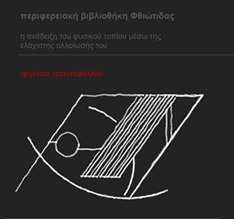

Sources of knowledge are provided to people through many social institutions. A fundamental social institution that provides information and supports knowledge is a library. During the past few year in the city of Lamia takes place a development that concerns the creation of an Institution of Higher Education as well as a future creation of more. The existing library of Lamia does not suffice and cannot cover the needs of today’s rapid growth. Therefore, there is an imperative need for the creation of a new library. The composition is based on the idea of the reconstruction of the hill in its initial form before the construction of the hospital that exists there now and will be transported. The building, therefore, is developed inside the hill as a part of it and its landscape. The main axis of the building is the axis of the entry that conceivably connects the hospital with the city. Paralleled with this axis are developed the rest of the main axes of the building that includes the following elements: a vertical volume to these axes, one central atrium to which are directed all the facades of the building and another atrium that contributes to the distinction of the most basic volume of the building, which distinguishes from it, includes the main volume of its reading rooms and helps the building to be seen by the people that comes by. Also, in the atrium, there is an observatory that connects all the elements of the project to the mountain and to the city. Finally, the large spaces of glass and the formation of the atrium with all kinds of materials and with surfaces of water contribute to the completion of the building. At the same time, the fact that it is an underground building contributes to the saving of energy, because of the great thermal mass of the ground. The library includes several departments such as: the department of the historical triangle, a department of magazines, an isolated department, a department with computers, a department that includes historical files and the administration of the whole building. All the departments of the library along with the administration and the way that the building is structured are composed so that it functions properly, it serves its users and it attracts new ones.
Supervisor: Triantafillidis Giorgos
Reference Number: 217


The “open” kindergarten requires variety and flexibility regarding the actions and space. It raises children initiatives and the interaction with daily life in fundamental concern, that can be achieved through game and teams. For its accommodation, a live architecture is needed to interact during the educational process mainly with the child, but also with society. The space limits owe to be perforated, allowing its extension in the social reality. That for, it is necessary to create small, scattered activity regions outside the main building. Thus, a continuing dialog is achieved between the child, the society and the environment. The space must be experientially and structurally flexible. It should be able to accept many different practices of use without changes. Thus, ways of action will not be dictated to the children. In the contrary, the space will challenge them to explore regions of game, their body and its relation with the environment freely and without restrictions. Additionally, it is necessary that the children are provided the ability to change it substantially and radically. The space is a part of the educational experience and can achieve its purpose only when the body and the space itself enter a dynamic relation of exchange.
Therefore, it is essential for the kindergarten to find its own territorial identity far away from mimicry and symbolism. This identity must not only arise from the significance and the function of the new, child-oriented, school, but also answer to the social requirements.
Supervisor: Kanarelis Theoklis
Reference Number: 209

